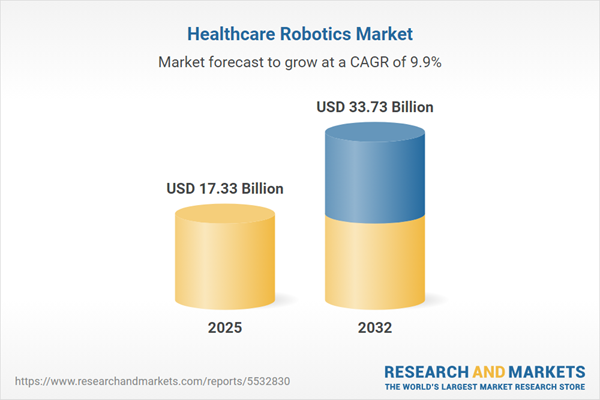Speak directly to the analyst to clarify any post sales queries you may have.
The healthcare robotics market is enabling healthcare leaders to build resilient, efficient operational models that meet evolving clinical demands. As automation continues to reshape patient care and workflows, senior executives require strategic guidance to leverage advanced robotics and maintain a competitive edge.
Market Snapshot: Advances in Healthcare Robotics
The healthcare robotics market is driving a global shift in clinical practice, fueled by significant international demand for solutions that enhance process consistency and operational efficiency. Market expansion aligns with healthcare’s digital evolution, as providers adopt new technologies to secure adaptable and reliable patient outcomes. Institutions are deploying robotics to support flexible responses to changing care needs and regulatory landscapes. Both established and emerging healthcare systems are using these innovations to resolve persistent challenges, enabling investment in scalable operational models for the future. These developments reflect the market’s strong growth trajectory and highlight its increasing significance for healthcare leadership.
Scope & Segmentation: Core Components of the Healthcare Robotics Market
- Product Types: Robotic platforms serve diverse clinical roles, including diagnostics, imaging, noninvasive radiosurgery, pharmacy and laboratory automation, therapeutic and assistive care, logistics, and advanced surgical procedures. These products support precise, repeatable performance in acute, outpatient, and long-term care environments.
- Technologies: Artificial intelligence delivers intelligent decision support and reduces clinical workloads. Augmented reality facilitates interactive staff training, while IoT ensures real-time monitoring and oversight. Machine learning applications strengthen diagnostic accuracy and adaptive process automation.
- Applications: Use cases span cardiology, neurology, laparoscopy, and orthopedics, supporting not only accurate diagnosis but also workflow optimization and improved treatment quality for a range of care settings.
- End-Users: Hospitals, clinics, surgical suites, rehabilitation centers, ambulatory care, and day surgery operators are integrating robotics to streamline clinical operations and allocate resources efficiently across multidisciplinary teams.
- Regions: Adoption trends differ across the Americas, Europe, Middle East and Africa, and Asia-Pacific, shaped by respective regulatory environments, funding models, and readiness for healthcare innovation.
- Companies: Leading vendors—including Asensus Surgical US, FANUC Corporation, Intuitive Surgical, Johnson & Johnson Services, Medtronic, Parker Hannifin Corporation, Robocath SA, Siemens AG, Stryker Corporation, and Zimmer Biomet Holdings—sustain competitive advantage through diverse solution portfolios and ongoing innovation.
Detailed segmentation highlights the broad market footprint, with advanced AI and IoT enabling interoperable solutions that connect healthcare networks. Flexible architectures help organizations customize deployments according to institutional objectives, adapting as clinical pressures and care priorities evolve.
Healthcare Robotics Market: Key Takeaways for Senior Decision-Makers
- Integrating robotic systems and artificial intelligence strengthens procedural consistency and organizational resilience, supporting coordinated care across multiple locations.
- Modernizing workflows through automation expands institutional capacity for scalable care delivery, such as telemedicine, and enhances resource allocation across departments.
- Collaboration among healthcare providers, technology companies, and academic partners accelerates adoption of innovations like augmented reality and predictive analytics, maximizing the value and reach of emerging solutions.
- Adapting to dynamic regulatory and reimbursement standards increases compliance and can streamline strategies for entering or expanding in key markets.
- Focusing investment on research, development, partnerships, or acquisitions positions organizations to meet evolving clinical requirements and scale operationally over time.
- Leveraging data-driven operational frameworks enables rapid adaptation to changing patient expectations and shifting benchmarks in care delivery.
Tariff Impact: Managing Costs and Securing Supply Chains
Forthcoming United States tariffs planned for 2025 may alter the cost structure for imported robotic components within the healthcare robotics sector. Senior decision-makers can minimize operational and procurement risks by diversifying supplier networks, strengthening ties with regional manufacturers, and regularly evaluating sourcing strategies. Transparent supplier communication and robust inventory planning offer stability in a variable market environment.
Methodology & Data Sources
This analysis leverages academic research, clinical registry data, patent reviews, regulatory documentation, and insights from executive and supply chain interviews. This robust methodological approach offers senior leaders actionable, evidence-based guidance for adopting and integrating healthcare robotics solutions.
Why This Report Matters
- Provides practical recommendations for leadership teams guiding investment, procurement, and operational change toward seamless robotics integration.
- Enables organizations to respond proactively to regulatory shifts, develop impactful partnerships, and mitigate risks within global supply chains.
- Supports workforce and workflow planning as technological maturity transforms care delivery standards and patient engagement models.
Conclusion
Healthcare robotics supports strategic transformation in care quality and operational efficiency. Prioritizing automation and organizational adaptability positions healthcare institutions for sustained success in a changing environment.
Additional Product Information:
- Purchase of this report includes 1 year online access with quarterly updates.
- This report can be updated on request. Please contact our Customer Experience team using the Ask a Question widget on our website.
Table of Contents
3. Executive Summary
4. Market Overview
7. Cumulative Impact of Artificial Intelligence 2025
Companies Mentioned
The companies profiled in this Healthcare Robotics market report include:- Asensus Surgical US, Inc.
- FANUC Corporation
- Intuitive Surgical, Inc.
- Johnson & Johnson Services, Inc.
- Medtronic PLC
- Parker Hannifin Corporation
- Robocath SA
- Siemens AG
- Stryker Corporation
- Zimmer Biomet Holdings, Inc.
Table Information
| Report Attribute | Details |
|---|---|
| No. of Pages | 191 |
| Published | November 2025 |
| Forecast Period | 2025 - 2032 |
| Estimated Market Value ( USD | $ 17.33 Billion |
| Forecasted Market Value ( USD | $ 33.73 Billion |
| Compound Annual Growth Rate | 9.9% |
| Regions Covered | Global |
| No. of Companies Mentioned | 11 |









